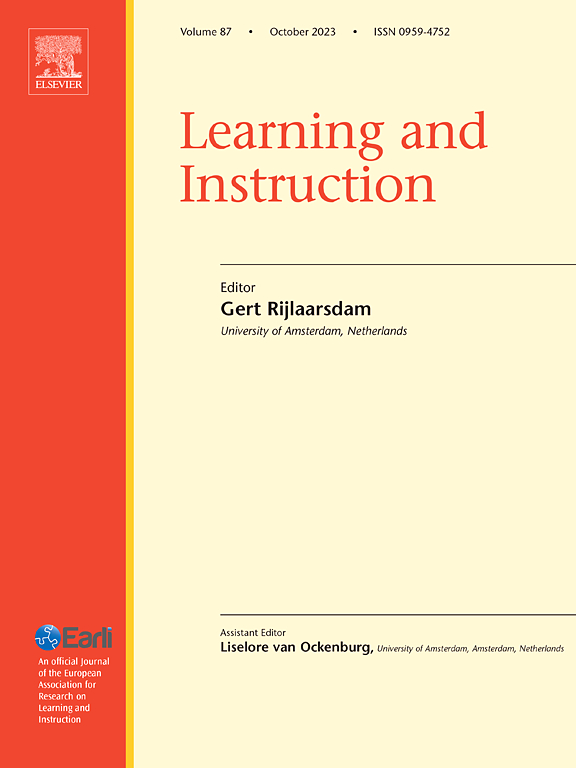Testing individual and group markers of collaboration in a team-based learning classroom
IF 4.9
1区 教育学
Q1 EDUCATION & EDUCATIONAL RESEARCH
引用次数: 0
Abstract
Background
Intra-group discussions during actual TBL sessions play a huge role in knowledge consolidation and learning but are often understudied.
Aims
Using a pre-registered study framework, we examined if participation equity (H1), reciprocal interaction (H2), information density (H3), mutual understanding (H4), and emotional rapport (H5) affected how much students learn from their intra-group team-based learning discussions and how they rated their team's discussions.
Sample
Participants were 165 undergraduate students assigned to 28 teams.
Methods
Using linguistic, conversational, and socio-affective features extracted from recordings of Year 1 and 2 medical students engaging in team-based learning, each construct was conceptualised at the level of the group and the individual. We used linear mixed-effects models and competing models approach to establish which of our metrics best account for the observed variance in individual learning gains and perceived collaboration quality. The analysis plan was preregistered, including correction for multiple comparisons.
Results
None of our individual-level or group-level metrics significantly predicted individual learning gains. One of the group-level metrics significantly predicted perceived collaboration quality: reciprocal interaction. Our exploratory analysis found that individual baseline score of the best performer in the team positively predicted individual learning gains for others in their team, regardless of other interaction metrics.
Conclusion
While students perceived the highest collaboration quality when turn-taking in their team was evenly distributed, the strongest predicter of learning gains for a student was the knowledge level of their top-scoring team-mate. This finding has implications for classroom equity, group formation and activity planning.
在以团队为基础的学习课堂中测试个人和小组的协作标记
背景:在实际的TBL课程中,小组讨论在知识巩固和学习中发挥着巨大的作用,但往往没有得到充分的研究。目的:使用预先注册的研究框架,我们研究了参与公平(H1)、互惠互动(H2)、信息密度(H3)、相互理解(H4)和情感融洽(H5)是否影响学生从小组内部团队学习讨论中学习的程度,以及他们如何评价团队讨论。样本参与者是被分配到28个小组的165名本科生。方法利用从一年级和二年级医学生参与团队学习的录音中提取的语言、会话和社会情感特征,在群体和个人层面对每个构念进行概念化。我们使用线性混合效应模型和竞争模型方法来确定我们的指标中哪一个最能说明在个人学习收益和感知协作质量方面观察到的差异。分析计划进行了预登记,包括多重比较的校正。结果我们的个人水平或群体水平指标都不能显著预测个人学习收益。其中一个组级指标显著地预测了感知到的协作质量:互惠互动。我们的探索性分析发现,团队中表现最好的人的个人基线分数积极地预测了团队中其他人的个人学习收益,而不管其他交互指标如何。结论当学生在小组中轮流时,他们认为学生的协作质量最高,但学生学习收益的最强预测因子是得分最高的队友的知识水平。这一发现对课堂公平、小组形成和活动规划具有启示意义。
本文章由计算机程序翻译,如有差异,请以英文原文为准。
求助全文
约1分钟内获得全文
求助全文
来源期刊

Learning and Instruction
Multiple-
CiteScore
11.30
自引率
4.80%
发文量
109
期刊介绍:
As an international, multi-disciplinary, peer-refereed journal, Learning and Instruction provides a platform for the publication of the most advanced scientific research in the areas of learning, development, instruction and teaching. The journal welcomes original empirical investigations. The papers may represent a variety of theoretical perspectives and different methodological approaches. They may refer to any age level, from infants to adults and to a diversity of learning and instructional settings, from laboratory experiments to field studies. The major criteria in the review and the selection process concern the significance of the contribution to the area of learning and instruction, and the rigor of the study.
 求助内容:
求助内容: 应助结果提醒方式:
应助结果提醒方式:


